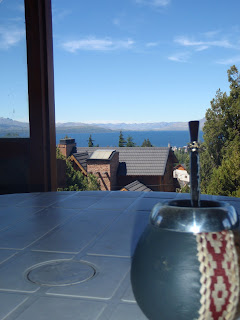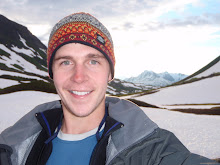"Rithm Machin!"
"Dancing Dat AND Nigth"
Now I'm going to recognize the smirk of Chines tourists who come to America and see our tattoos.
The other day I spent the afternoon reading and doing my homework at the beach. It was a day without wind, so the lake was mirror-clear. For six dollars I rented a kayak for a couple of hours, cruised along the rocky beach (I was supposed to stay in sight of the rental shack), and enjoyed looking out at the Andes on the not-so-distant opposite shore.
(Footnote: my computer's background has a constant weather tracker and it tells me that it is currently 37 and rainy in High Point.)
Yesterday I took a public bus (cheap and crowded like a third-world bus, everyone huddled in the aisle, with chest and butt awkwardly pressed against neighbors, except that everyone smelled really nice and was wearing hiking boots and carrying outdoorsy Swiss designer packs I have never heard of) to a bike rental shop 18 km outside of the city. I spent hours circling an arm of the giant Lake Nahuel Huapi - terrible uphills ("These are killing me!", my cycling companion from Buenos Aires kept saying) followed by equally terrifying downhills. But the views all around were the reward. I met other travelers along the way, and ended up finishing the day's route at a little restaurant nestled on a mountain, far off the main death-road, with my BA amigo and a couple of cool students from California.

A view from the bike at "panoramic point".
Point being, incredible mountains and fresh air adventure are available just a few km outside of my home here. This is one of the spheres of Bariloche.
The visible Bariloche has two main worlds: the fun-touristy and the way-too-touristy. Like any good vacation town, the poverty is hidden on the other side of the mountain - if the tourists see it at all, its probably from the safe distance of a stunning moutaintop view.
In the fun-touristy, I can easily rent a kayak and cruise the fjords for an afternoon, all for a steep 6 bucks. There are beaches, delicious panaderias, the best ice cream I've ever had made from berries I've never heard of, three guitar lessons a week in the styles of tango, folklore, and flamenco, and well-maintained mountain trails. I love all this stuff. I've had a great time and met some interesting travelers, and since it's summer in only this hemisphere, even the tourists speak Spanish.
And here comes the "but..." - a place made of a constant stream of tourists is a little bit polished.
The other day I found the exact middle point on the touristy scale, right there on the border betwen gentle diversion and nauseatingly vapid touristyness. I kept seeing posters all over town of a concert called "From the Andes to the Beetles" so of course, I caved in and went on a Tuesday night. The small theater was packed, mostly with folks from around Buenos Aires (it is half of the country's population). The stage was set up with guitars and churangos (Andean mandolins) and those pan-flutes made of different-sized reeds tied together. I don't know what I was expecting, but it surprised me that the musicians that took the stage were in their 60s, obviously the type of educated part-time musicians who are doctors and architects in their spare time. Most of the songs were beautiful, with McCartney melodies on the reed flute. But they even tried some psychedelic stuff, and this old lady who should've stuck with the churango tried to play what she called a "metal solo" on a distorted electric guitar during "I Am The Walrus". It was really terrible. I seriously had to close my eyes.

I tried to leave abruptly after the show but the rollicking applause from the Buenos Aryans brought the Beatles back on stage for, not one, but TWO identical renditions of the same "Hey Jude" and "Blackbird" they had already played. Like I said, they were beautiful the first time, but instead of introducing me to the Andean culture they made me practically run from the theater to find something reminding me that I was truly in South America, not some Spanish-speaking American city, maybe Miami.
I am not complaining about Bariloche, just observing. I have come to love it's charm, no matter how polished, though I do really wonder what it looks like in the off-season. I am a tourist too, I keep reminding myself.
After a couple of weeks, when I got the feeling that I was supposed to have experienced the city already, I just had to get good at venturing a little farther outside of the city, where the real Barilocheans live and play.
Quick example: this weekend I made my way to El Bolson, a Patagonian hippie hideaway famous around the country. To give you an idea of the culture of the place, there are drum circles, organic foods, a huge Saturday artisan fair with a dreadlock percentage of about 25%. I bought a lot of gifts. This is a place that declared itself a "non-nuclear zone" in the 60s, and since then the vibe of "amor y paz" has pretty much remained, albeit a more touristied version.
The first night there, after getting settled into a hostel, I walked into the town's central park to see a giant movie theater sized screen and projector set up. About 100 folks were just hanging around, watching a Bob Marley concert on the screen. Needless to say, I really liked the place.
I did a sweet day hike in the area that included a real life Indiana Jones swinging plank bridge. Even the official sign next to it seemed concerned, "No more than one person at a time or 300 pounds."

We took the famous Route 40 through Patagonia, winding up and down, right along the Andean cordillera all the way down. It was worth it just for the drive.













